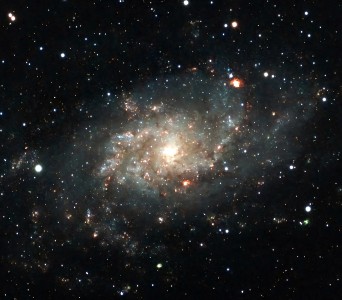Jupiter is Changing its Stripes Right in Front of Our Eyes

Jupiter is wrapped in flowing bands of yellows, browns, and whites. These bands are produced by the atmosphere flowing in different directions at various latitudes. Lighter-hued areas where the atmosphere rises are called zones. Darker regions where the atmosphere falls are called belts. When these opposing flows interact, storms and turbulence appear.
Between March 25 and June 5, 2007, Hubble's Wide Field and Planetary Camera 2 captured entire bands of clouds changing color. Zones have darkened into belts and belts have lightened and transformed into zones. Cloud features have rapidly altered in shape and size.
Recent "before and after" images show the dramatic changes. The image on the left shows a thin band of white clouds above Jupiter's equator. The white color indicates clouds at higher altitudes in Jupiter's atmosphere. The image on the right shows that the band's white hue has turned brown, showing clouds deep within the planet's atmosphere. The whole band appears to have merged with the one below it.
In the same cloud band above the equator, the small swirls in the image on the left have morphed into larger wave-like features in the right-hand photo. Dominating the band is a dark streak that resembles a snake. This serpent-shaped structure is actually a small tear in the cloud deck, which gives astronomers a view deep within the atmosphere.
Below the equatorial region, the brownish upside-down shark fin in the left-hand image disappears in the photo at right. Appearing instead are brownish tongue-shaped clouds with a stream of white swirls below them.
These global upheavals have been seen before, but not with Hubble's sharp resolution. Astronomers using ground-based telescopes first spied drastic atmospheric transformation in the 1980s. Another major disturbance was seen in the early 1990s, after Hubble was launched into space. The telescope, however, did not have the resolution to view the upheaval in fine detail. These higher-quality Hubble images may help astronomers understand how such global upheavals develop on Jupiter.
For more information:
http://hubblesite.org/newscenter/archive/releases/2007/25/
http://www.newswise.com/articles/view/531164/
http://www.astromart.com/news/news.asp?news_id=384
http://www.astromart.com/news/news.asp?news_id=545
Between March 25 and June 5, 2007, Hubble's Wide Field and Planetary Camera 2 captured entire bands of clouds changing color. Zones have darkened into belts and belts have lightened and transformed into zones. Cloud features have rapidly altered in shape and size.
Recent "before and after" images show the dramatic changes. The image on the left shows a thin band of white clouds above Jupiter's equator. The white color indicates clouds at higher altitudes in Jupiter's atmosphere. The image on the right shows that the band's white hue has turned brown, showing clouds deep within the planet's atmosphere. The whole band appears to have merged with the one below it.
In the same cloud band above the equator, the small swirls in the image on the left have morphed into larger wave-like features in the right-hand photo. Dominating the band is a dark streak that resembles a snake. This serpent-shaped structure is actually a small tear in the cloud deck, which gives astronomers a view deep within the atmosphere.
Below the equatorial region, the brownish upside-down shark fin in the left-hand image disappears in the photo at right. Appearing instead are brownish tongue-shaped clouds with a stream of white swirls below them.
These global upheavals have been seen before, but not with Hubble's sharp resolution. Astronomers using ground-based telescopes first spied drastic atmospheric transformation in the 1980s. Another major disturbance was seen in the early 1990s, after Hubble was launched into space. The telescope, however, did not have the resolution to view the upheaval in fine detail. These higher-quality Hubble images may help astronomers understand how such global upheavals develop on Jupiter.
For more information:
http://hubblesite.org/newscenter/archive/releases/2007/25/
http://www.newswise.com/articles/view/531164/
http://www.astromart.com/news/news.asp?news_id=384
http://www.astromart.com/news/news.asp?news_id=545



